Manu A B in Mumbai
For the villagers of Tamkuha, a dusty hamlet in rural Bihar, Gyanesh Pandey is the modern day alchemist who transformed piles of discarded rice husk to light up their lives.
Today, every household in Tamkuha has been literally lifted out of darkness with an uninterrupted, self-sufficient power supply, which many towns and cities in India still have not been able to achieve even 60 years after Independence.
Tamkuha, however, is not alone in this matter. Around 50,000 villagers in 120 villages across Bihar and 3 villages in Uttar Pradesh have been benefited by these 'green' power plants.
For villagers, this cheap and eco-friendly model of generating electricity is a miracle that has transformed their lives. No wonder Gyanesh Pandey, the 33-year-old Non-Resident Indian has won the hearts of many poor villagers. "Aap Bhagwan ho (you are God!)!" said a poor villager to Gyanesh Pandey, when he first saw his house lit up.
After relinquishing a successful career in the United States, Gyanesh returned to his native home state in 2007. A mind-altering Vipasana session reaffirmed his desire to come back to Bihar.
He teamed up with his friends Ratnesh Yadav, Manoj Sinha and Charles W Ransler to set up Husk Power Systems, three years ago. Gyanesh, Ratnesh and Manoj had borne the burnt of the power crisis and many problems while growing up and studying in rural Bihar.
Their idea was simple: to provide power to villagers who depended on agriculture as their main occupation in a cost-effective and environmentally-friendly manner. After six years of research and experiments, the team decided that the most feasible way would be making electricity from rice husk.
Many were skeptical about its success. But today, HPS owns and operates 40 mini-power plants (35-100 kw) across Bihar. Through this unique green technology, villages get uninterrupted power for up to 6-12 hours by setting up a plant, which burns rice husk to generate gas to run generators.
"After 60 years of independence, we got the real azadi (freedom) now," Rambalak Yadav, an excited school teacher from Tamkuha, said.
Gyanesh admits he never liked anything about Bihar. So it was a conscious decision to move to the United States. However, years later, he felt India calling him back. Although he kept away from his native place for years, deep within, he knew that one day he needed to come back and work for the upliftment of these villages.
"Becoming an entrepreneur was an evolutionary process. I had a good life in America. I did not face any problems there, but I always had the feeling that I must do something for our villages. I do not feel I have made any sacrifice. Today, there is hardly anything I do other than work. It gives me the satisfaction no job can ever give," says Gyanesh, who feels India's acute power crisis must be solved efficiently with renewable resources.
The company is set to make profits by the end of this year and plans to light up villages in other states like Maharastra, West Bengal, Uttar Pradesh and Tamil Nadu.
Providing electricity to villages across India is just the beginning of Gyanesh's ambitious plan to transform rural India. The company has already taken up the initiative to educate 200 children from Tumkuha.
An optimistic and determined Gyanesh is chalking out a grand vision to build an integrated network to upgrade health, education and energy needs of India's poorest people. He shares the excitement, the trials and tribulations of bringing light in the lives of hundreds of poor people.
So how is electricity made from rice husk? Click NEXT to find out...You can write to Gyanesh Pandey at info@huskpowersystems.com
He is lighting up villages with rice husk!
Image: Ratnesh Yadav, Gyanesh Pandey, Simon, Manoj Sinha (L to R).Why did you decide to become an entrepreneur? How did you get the idea of making electricity for rice husk?
I always dreamt of making life livable for people in the villages. I did not have a concrete idea as to how I should go about doing this. I was working as a senior project manager in International Rectifiers in the United States. From 2002, I have been thinking of a strategy that could help solve the two major problems in India -- water and energy crises.
Finally, we decided to go ahead to with energy solution. Providing a reliable and efficient source of electricity could help people the most. It took us six years of trial and error method, research and hard work before we could zero-in on making this a viable business plan.
The process of gasification by converting farm waste to produce electricity was known. But no one had actually implemented such a low-cost model anywhere in the world. Many people thought we were stupid to do this. However, a scientist at the Ministry of Renewable Resources supported our plan.
It was not difficult to get funds. In fact, funding poured in from all quarters; so it was an easy start. We had to start and see how it runs. Once it got it running, it was like getting a magic lamp. You rub it and get things done.
How is rice husk converted into electricity? How much of rice husk is required for this process?
The process of gasification involves controlled burning of the biomass to produce a particular cocktail of gases, called the producer gas. This gas is a mixture of carbon monoxide, nitrogen, hydrogen, carbon dioxide and a little bit of methane.
Producer gas is a combustible gas. It is fed into a gas engine, which drives an alternator to produce electricity. About 2 kg of rice husk is required to produce 1 kilowatt of electricity.
...He is lighting up villages with rice husk!
Image: Night view of gasifier platform and operator's house at Madhubani plant.How are the houses connected and how is the metering done? What would be the monthly usage charge?
Households are connected to our mini-distribution grid, which is formed by laying out double-insulated cables on bamboo poles. The baseline charge is Rs 80 for two compact fluorescent lamps (CFL) and mobile charging per month. Consumers pay discounted prices for higher consumption.
How cost-effective is the power generation compared to a conventional power supply?
We charge Rs 40 for a 15 watts CFL (25-30 W, considering the power factor), besides Rs 80-100 to take a connection. This is cost-effective and non-polluting. There are no fixed charges (i.e. meter charges, et cetera as in a conventional electricity bill). A household with one fan and one CFL would pay about Rs 120 per month. (At many places like Patna consumers pay about Rs 250 in fixed charges alone).
...
He is lighting up villages with rice husk!
Image: Rice sheller machine at Tamkuha village.How many villages have husk power? How many hours will each house get power?
Besides 123 villages in Bihar, we provide electricity to 3 villages in eastern Uttar Pradesh. One plant can cater to 1-5 villages depending on the number of households. Currently, we provide power for up to 12 hours. We can scale this up to uninterrupted connectivity but there is no demand. We are working in the remote villages where people have just started realising the benefits of electricity.
Most of the people live in small huts and they need just one light fixture. Many houses do not have fans or any other electrical appliance. So it will take time to scale up operations.
What kind of positive changes have come about in villages after husk power?This is certainly a welcome change in the villages. People can work longer if they wish to at night. Children who used kerosene lamps are able to study better. Women can do the cooking at a convenient time instead of rushing during the day time.
Snake bites and burglaries have also decreased. Shopkeepers do business for a longer time. Electricity will also help set up small-scale units in the villages.
...
He is lighting up villages with rice husk!
Image: Malahitola plant under installation.How long does it take to set up a plant? What is the cost of setting up a plant?
Each plant takes about 3 months to get started. This can go up to5 months depending on how many houses need to be connected. We work on a build-own-operate-maintain basis. We have hired local people and trained them to run these plants.
We have also set up a HPS University curriculum to train these workers. We have set up 40 plants so far. Each plant costs less than Rs 15 lakh (Rs 1.5 million) for generation as well as the distribution grid, and generates about 32 kilowatts of electricity. We follow the '3 Rs' -- Reliable, Renewable, and Rural.
How much has the company invested so far? Did you face financial constraints?
The company has already raised about $2.5 million from various institutions. The World Bank's International Finance Corporation approved a $1.5 million financing plan. It received another grant of $75,000 grant from Royal Dutch Shell's Foundation, besides equity investment, grants and subsidies from the government.
...
He is lighting up villages with rice husk!
Image: Children look at the Husk Power plant at Malahitola.How do you see India's power crisis? What role can husk power play in solving India's power woes?
India faces an acute power crisis as more than 125,000 Indian villages still do not have electricity. There is a total misuse of electricity in cities and big factories.
At many places, there is mismanagement in supply and distribution of electricity. Many villages have been identified by the government as economically unviable to reach though a conventional method. There is a need for decentralisation to reach out to more villages. We must switch over to non-conventional resources.
Other power options like kerosene lanterns and diesel generators are uneconomical and inefficient. Electricity is the first step in transforming these villages. Our company has identified 25,000 villages as feasible sites within India's rice-producing area for its projects.
There has to be a paradigm shift in the way we manage the power supply and distribution. Besides, impacting the lives of hundreds of villagers, we are also creating many jobs at the local level for money collectors, training workers to maintain plants and the network, etc.
...
He is lighting up villages with rice husk!
Image: Electricity brings a new life to this village.How is the experience of working in Bihar?
Working in Bihar has its advantages and disadvantages. People are quite unpredictable here. The development is not uniform. There is no quality of work here. Life is tough, but I had some pleasant surprises here. Till now our company did not have to bribe anyone to get anything done, which I feel is a positive thing.
Dealing with the government has been easy. The state is plagued by several problems. There is not a single metro city in the state. The lack of development and lack of opportunities have resulted in mass migration. Our efforts are to stop this and bring about opportunities for people in the state.
What kind of difficulties did you face initially?
This is the best thing I ever did. There were not many difficulties as this was a unique project and the result would benefit many villages. It took some time to convince villagers. But they do no have large needs. To make them realize what they were going to get was difficult.
They had never dreamt of getting electricity. However, Charles W Ransler, one of our co-founders, had health problems after he came here and had to leave.
...
He is lighting up villages with rice husk!
Image: Gyanesh Pandey, Simon at Malahitola plant.I did not really make to make any sacrifice. Life is tough here but I opted it as my vision is big. I have big dreams in terms of improving the lives of villagers across India. I am determined to work against the odds to make this mission successful. My work is like painting on a big canvas. The work has started and am confident it will turn out to be a beautiful painting.
How supportive was your family?
My family was not too keen on me taking this risk. Just like all other parents, they had apprehensions about this venture. They wanted to me to continue with the job. But I was determined to work on what I really wanted to do and I am happy it has worked well so far.
People here have a different way of thinking. They cannot relate to new ideas. I had already spent 6 years on various experiments and I had to make this work. But as a good gesture, my father helped me financially when I started working.
...
He is lighting up villages with rice husk
Image: Rice husk, the source of power.Not at all. We have some of the best employees which include IIT-ians and MBA graduates from foreign universities, like Wharton. They are excited about working for a project like this. We pay them at par with the industry standards. For them it is a rare opportunity. It is amazing to have them work with us.
Is this a profitable business? When will you break even?
This is definitely a very profitable business. We are working on a margin of 46 per cent at the unit level, which is considerably good. We will start generating profits by the end of this year.
...
He is lighting up villages with rice husk!
Image: Tamkuha villagers look forward to a bright future.What kind of challenges do you face in this project?
The biigest challenge always is to get the right people for the right job. Besides, convincing villagers about the need to bring about a change in their lives was tough. We need a continuous supply of machines and manpower to effectively implant our plans.What is the response from the people?
I have been getting a lot of compliments from government authorities and local people. These are truly motivating. Some times I do brickbats. If by any chance power goes off, instead of calling the person in-charge they call me up and scream at me.
Our systems have a running efficiency of up to 99 per cent but there are times when a circuit breaks and people get furious, which I think is their way of showing appreciation for electricity.
...
He is lighting up villages with rice husk!
Image: Gyanesh Pandey with the villagers.After going abroad, people hardly think about their own country? What made you think differently?
Yes, that's true. I did not like India. After I went to the US, I came back only after 4 years. I was not happy with the way people worked and the pace of development here. But the good thing is I had the drive, a motivating factor from within, to work in India. No one pushed me to do this.
The attitude among the NRIs is gradually changing. I had grown up in West Champaran, one of the most backward regions in Bihar. So I knew the problems of the people. After I finished my electrical engineering course from IIT-Varanasi, I decided to go abroad for further studies.
I did my MS from Rensselaer Polytechnic Institute. Though I enjoyed my work, I was not really comfortable because I knew this is not exactly I wanted to do. I was not really looking for a luxurious life. I knew my canvas was much larger. There was a lot I could achieve in my homeland.
Were you always studious? How important is education for an entrepreneur?
Education is definitely an important factor. It is essential to be diligent in your studies though I always lived by my whims. I did not score high grades during my school days.
We did not have much choice when we were studying. The pressure was always to become an engineer or a doctor or join the civil services. This was the mentality. After 12th standard, we just had three options, either take Maths, Biology or Commerce. I was forced to take Maths. I finally joined a college in Delhi and wasted a year as I did not enjoy the college life there.
Then I decided to go to IIT as someone said it is lot of fun. I got through the IIT-JEE and joined IIT-Varanasi. At the end of 4 years, I knew I was not prepared to work. So I decided to go the US for further studies.
...
He is lighting up villages with rice husk!
Image: A light glows near the Husk Power plant.It is all about efficient management. There is hardly anything else I do apart from work. Most of the time, I am travelling from one village to another. There are times when I have to take 30 decisions t the same time. And they have to be right and quick decisions. Very rarely do I get an opportunity to talk about something other than work. My mind is working 24 hours a day.
How important is innovation for an entrepreneurship to succeed?
Innovation is essential to build a sustainable solution. It is often driven by a necessity. The answer to the necessity has to be sustainable and cost-effective.
...
He is lighting up villages with rice husk!
Image: Gyanesh Pandel checks the Husk Power system at Malahitola.How can India become an innovation powerhouse?
Entrepreneurs must be respected and promoted. Entrepreneurship and innovation must be encouraged right from the school level. The nation's middle class needs to get out of the 60s mentality of pursuing a career of a secured job.
The country needs to generate its own streams of financing. Our nationalised banks need to grow up with modern times and start financing projects.
Do you believe India needs more entrepreneurs like you? Why don't more IIT-ians work for the development of our country?
India definitely needs more entrepreneurs. There is a huge opportunity to explore in India now. Earlier, we had four or five options but now there is lot of change. You have an opportunity to study what you like to and excel in many fields.
You must be bitten by the entrepreneurial bug and the motivation to create a beautiful solution must come from within. It is much easier for an Indian to dream today than it is for, say, an Ethiopian. It has become a breeding ground for so many ideas.
...
He is lighting up villages with rice husk!
Image: Malahitola village.Many of our rural innovations are ignored. What should be done? Why does the US lead in terms of innovations?
In India, there is a total disconnect between innovators and the society. People look at innovators from 20-storeyed buildings. They are not willing to step out of their office to understand real needs and solutions. No one really goes out to the filed and sees what is really happening.
If you have an idea here, no mater how brilliant it is, it takes a lot of time to implement it. People do not take you seriously. Whereas in America, if you discuss an idea, the immediate response is to see how this idea can immediately converted into a business.
Everything is possible if people care. In the US, people value your work and your efforts. India and China will have the maximum number of innovations if we give more attention to convert these ideas into business opportunities.
What are the most important things that entrepreneurs must have to succeed?
Patience, perseverance, long lasting hope, hard work and confidence are the most important.
What's your target in terms of providing electricity to villages? What are your company's future plans?
We are at the juncture of an explosion in terms of electrifying villages. By the end of this year, we plan to connect 200 villages in Bihar. We will also be starting power plants in rural areas of Maharashtra
We plan to have 2,014 plants by 2014. Besides, electrifying other villages across India, we also plan to make a foray into countries like Nepal, Indonesia, Cambodia and Ethiopia in the near future.
In India, our vision will be rural development with focus on education, healthcare, power and women's empowerment. In the coming years, we will implement programmes to address the most critical needs of rural people.

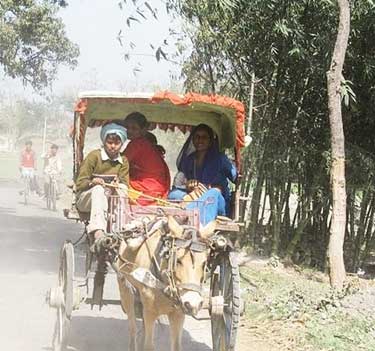



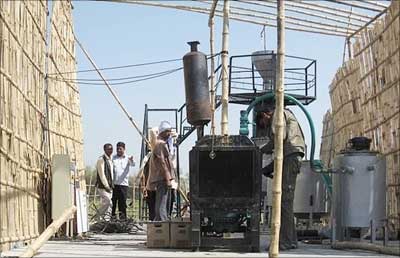
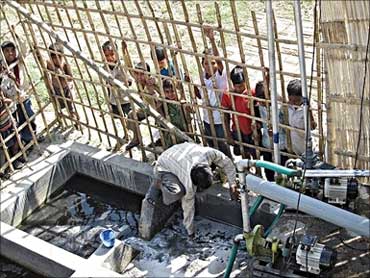



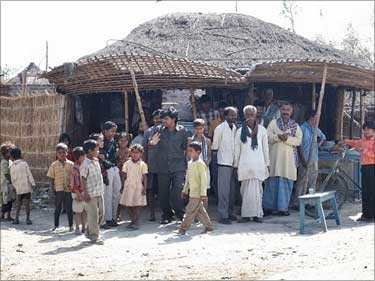
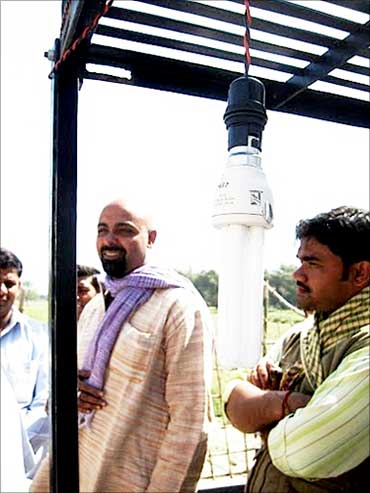
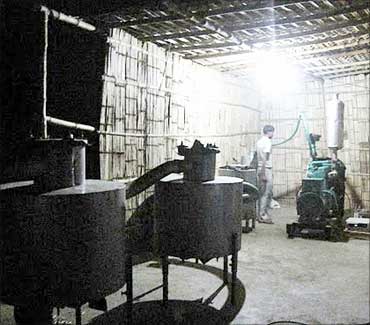
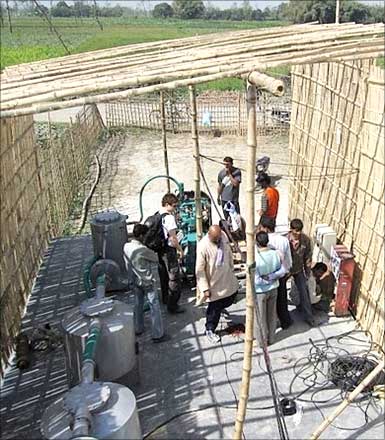
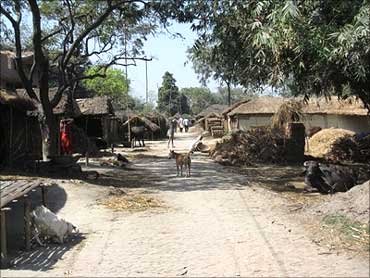
article